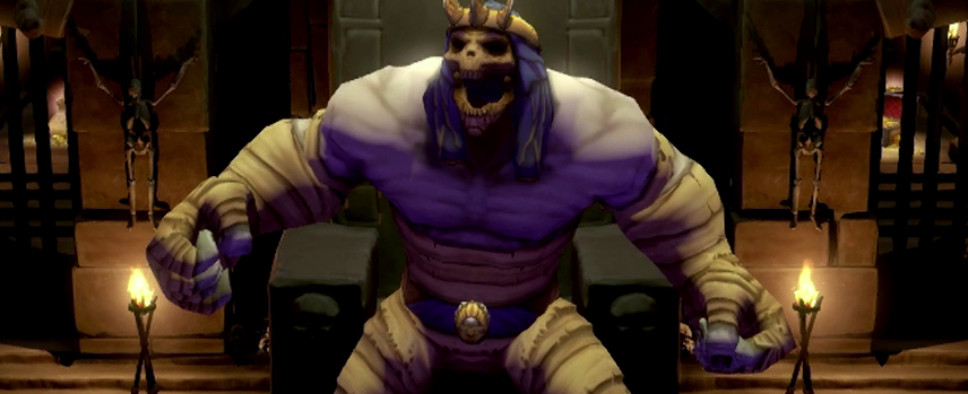Gauntlet Previews
-
Category: News ArchiveHits: 2135

A fistful of new (albeit brief) previews for Gauntlet, Warner Bros. and Arrowhead's forthcoming action RPG reboot, have reached the web over the past week. So without further ado, here's a full rundown of the reading material...
Destructoid:
Once you have the combat down, it's pretty much just a lot of that over and over. Clear rooms, collect loot, clear more rooms. The levels have a certain number of keys in them, the dastardly element in play being that there are more doors to unlock than keys available. Tough decisions have to be made about whether your party wants to go after rooms that feature food for health or ones filled with gold.
The only way that characters can be altered is through the use of relics. Relics can be found or dropped by enemies -- most likely bosses. Your party might not necessarily stay so cooperative once this happens. While gold is shared, relics aren't. They offer stat boosts, and are often the sought-after items by everyone.
The melee-based duo need to get into the thick of it fast, though, especially considering how easy it is for Elf and Wizard to pick off foes from afar. Elf plays it Legolas, with semi-automatic arrow proficiency, as well as a deadly powered shot that carves through everything in its path. Wizard was off limits during my first play-through due to his entry-level complexity, but I had a chance to take him for a spin at the end of the day. He plays differently to the other classes, in that his main proficiency is in setting spells before casting them in battle.
There is a basic ranged attack to keep swarming goons at bay, but the real fun is casting spells to control large groups. One spell created a massive explosion, which I rarely used because of aforementioned friendly fire concerns, but another created a black-hole implosion that pulled everyone in to its epicentre. The devs also assured me that the Wizard will be able to combine spells for the final release so, say, the black-hole implosion can be combined with a magical explosion which, at least conceptually, makes the Wizard sound like the most fun to play. He certainly was in my play-through.
When Arrowhead got the opportunity to make a game from Warner Bros. existing licenses, the developers jumped at the chance to make a Gauntlet game. Lindberg said they tried a number of different prototypes, including an isometric top-down look. However, this got in the way of the design working properly and having the right feel, so they went back to an overhead view.
Not that the game is without upgrades. While each class plays differently on a base level, they all also have major attacks with their own mechanic. For instance, the Elf has a sniper shot, the Warrior spins wildly while going berserk, and the Wizard can chain together different spell effects to create powerful combo attacks. In all cases, however, the special attacks can damage other players.
One of the most important design principles of Gauntlet was the introduction of four distinct player classes. This is something that Arrowhead has really taken to heart, and not only do the classes have different strengths and weaknesses; the mechanics themselves are different. The Elf for instance, one of two ranged characters, controls like a twin-stick shooter, where you move with one stick and shoot with the other. Like the original and unlike its sequel, the new Gauntlet doesn't allow for multiple characters of the same class. There is the Warrior and the Valkyrie for close quarter, where the Valkyrie has a shield block that allows for a different play-style compared to the more standard tank stylings of the Warrior. The Wizard wasn't properly tuned in the build we sampled so the developer took charge of that character.
The new Gauntlet looks to the original for the character classes you can play. The first is the Elf, an archer that uses the left thumbstick to aim and right trigger to shoot. He, like all the characters, also has a more powerful attack that is limited by a cooldown timer between uses. The Valkyrie, the lone female character, uses a spear to attack and can also create a blocking shield (the other characters must dodge enemy attacks). The Warrior is the classic melee tank, with more life and attack but less maneuverability. Finally, the Wizard is the magic user of the bunch, relying on powerful attacks that need to be recharged.
The four characters play very differently, and each requires a different strategy. In theory, they are all balanced with pros and cons, although time and several playthroughs will determine how true that is. From what we saw though, there was no clear dominant character (we played as both the Elf and the Valkyrie, and while the Elf took less damage, the Valkyrie had more kills).
And Shacknews:
Of course, each of the four characters has strengths and weaknesses. The Elf is rather weak when it comes to melee combat, but can strike well from a distance. The Wizard doesn't do much in terms of brute strength, but can unleash a number of spells to hit enemies quickly. As for the Valkyrie and Warrior, they're excellent when it comes to melee-based combat, but obviously don't have distance attacks.
All of these characters have special techniques that can be used sporadically, like the Elf's rebound shots and the Warrior's quick spinning attack, which can clear out an area effectively. These take time to recharge, but they're worth using when you're trying to protect your allies. Just remember: don't shoot the food. It's just as vulnerable here as it was in the original Atari games.

